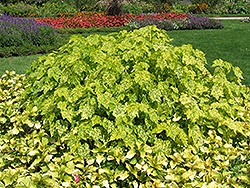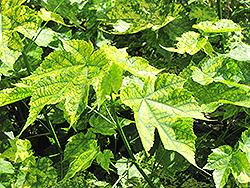Mardi Gras Flowering Maple Abutilon pictum 'Mardi Gras' Height: 10 feet Spread: 7 feet
Sunlight:
Hardiness Zone: (annual) Description: This variety produces an abundance of nodding, bell shapes orange-salmon flowers all year; prune annually in early spring to maintain size; a great container plant Ornamental Features Mardi Gras Flowering Maple features bold nodding orange bell-shaped flowers with salmon overtones along the branches from early spring to late winter. Its attractive lobed palmate leaves remain green in color with showy yellow variegation throughout the year. Landscape Attributes Mardi Gras Flowering Maple is a multi-stemmed annual with an upright spreading habit of growth. Its medium texture blends into the garden, but can always be balanced by a couple of finer or coarser plants for an effective composition. This plant will require occasional maintenance and upkeep, and is best pruned in late winter once the threat of extreme cold has passed. It is a good choice for attracting butterflies and hummingbirds to your yard. It has no significant negative characteristics. Mardi Gras Flowering Maple is recommended for the following landscape applications;
Planting & Growing Mardi Gras Flowering Maple will grow to be about 10 feet tall at maturity, with a spread of 7 feet. Although it's not a true annual, this plant can be expected to behave as an annual in our climate if left outdoors over the winter, usually needing replacement the following year. As such, gardeners should take into consideration that it will perform differently than it would in its native habitat. This plant does best in full sun to partial shade. It prefers to grow in average to moist conditions, and shouldn't be allowed to dry out. It is not particular as to soil type or pH. It is highly tolerant of urban pollution and will even thrive in inner city environments. This is a selected variety of a species not originally from North America. Mardi Gras Flowering Maple is a fine choice for the garden, but it is also a good selection for planting in outdoor pots and containers. Its large size and upright habit of growth lend it for use as a solitary accent, or in a composition surrounded by smaller plants around the base and those that spill over the edges. It is even sizeable enough that it can be grown alone in a suitable container. Note that when growing plants in outdoor containers and baskets, they may require more frequent waterings than they would in the yard or garden. Characteristics
Applications
Features & Attributes
|

